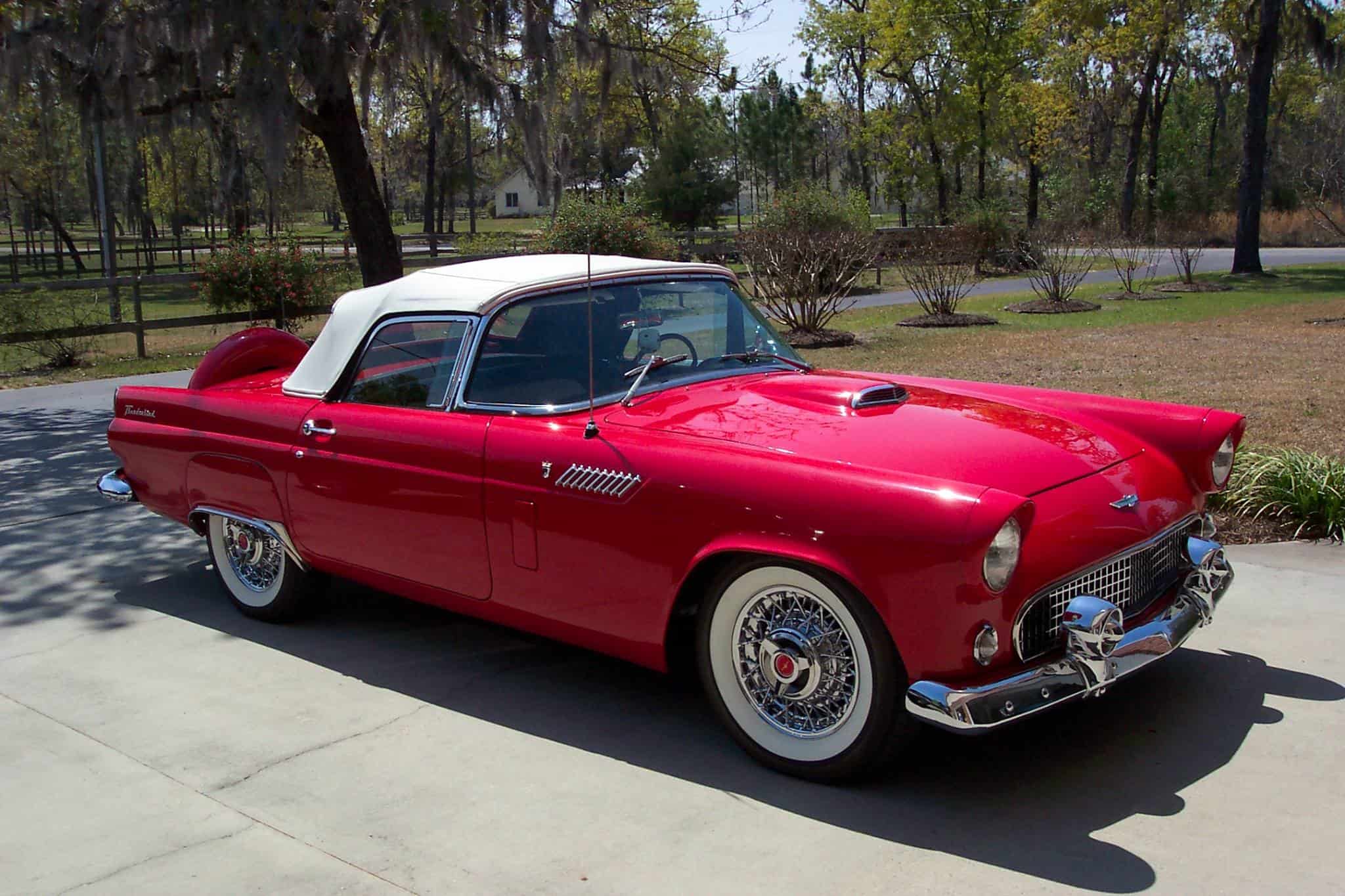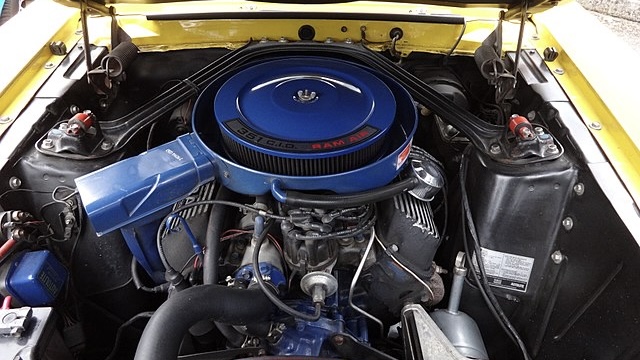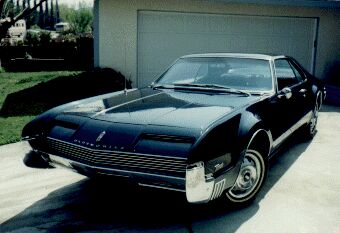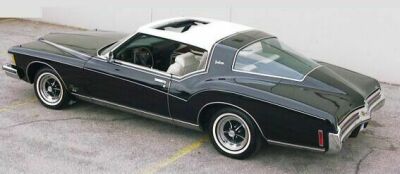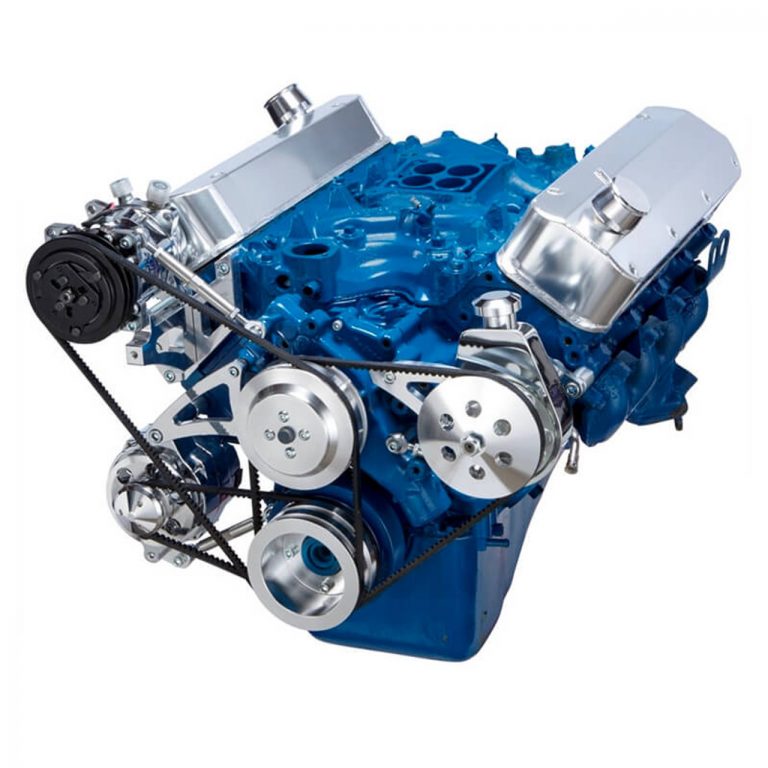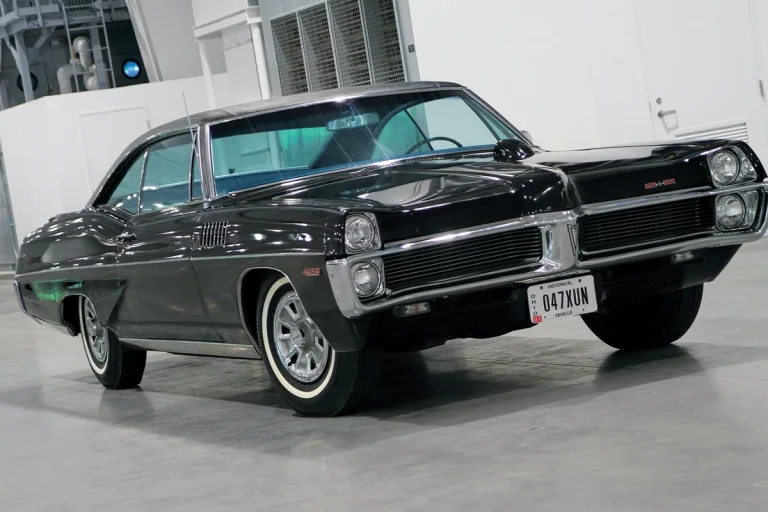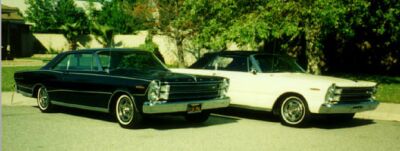Ford Thunderbird

Meet Chandler
Chandler has a bachelors and masters degree in history as well as a passion for classics and muscle cars. His education and historical knowledge makes him skilled at crafting highly detailed articles about America’s muscle cars and automotive history. His love of muscle cars is undeniable, with him seeking them out at every opportunity during his visits to auto shows and car meets. Chandler’s knowledge and enthusiasm towards automotive history make him a great asset to the Muscle Car Club community.
Spanning 50 years, the Ford Thunderbird is one of the most iconic cars in American history. First introduced for the 1955 model year, Ford marketed the Thunderbird as a personal luxury car that featured outstanding performance from big-block V8s. The original run of the Thunderbird lasted for 10 generations from the 1955–1997 model years, before Ford briefly halted production. It did make one last comeback from 2002–2005 for an 11th generation, but Ford has since retired the moniker again.
Also known as the “T-Bird,” in 1957 the Thunderbird became one of the first production cars with a factory equipped supercharger. The 1950s T-Birds are some of the most recognizable American cars of all-time, with their classic tailfins and headlights. From 1968–1971, Ford released the ThunderJet variant, which was essentially a muscle car with its 429 cid V8 engine pumping out 360 horsepower and almost 500 lb-ft of torque. This article will cover the first six generations of the Thunderbird, from 1955–1976. Make sure to check out our other article for the 1977–2005 Ford Thunderbird.
Ford Thunderbird, 1955–1976 Overview
The first six generations of the Ford Thunderbird spanned 22 model years from 1955–1976. The Thunderbird sold well, almost eclipsing 100,000 cars annually for a few model years. Originally, Ford only made the Thunderbird available as a two-door convertible with a removable fiberglass top, but soon they added a Rayon-top option, and in 1958 Ford introduced a four-seater version. In 1967, Ford brought out the first four-door T-Bird in history, which was very successful at first, but sales soon slumped.
The first generation of the Thunderbird lasted from 1955–1957. Available engines were either a 292 or 312 cid V8, and in 1957 a supercharger was added to increase horsepower and torque. Ford created the Thunderbird to compete with the Chevrolet Corvette that General Motors had released a few years earlier in 1953. The Thunderbird vastly outsold the Corvette even though they sold for similar prices. The T-Bird quickly became popular with racing enthusiasts, they were a staple of 1950s and 1960s drag racing.
Ford produced the second generation of the Thunderbird from 1958–1960, and in 1959 Ford gave the T-Bird its first big-block V8 engine, a 430 cid V8 making 350 horsepower and 490 lb-ft of torque. The car got some slight restyling and added a convertible option in 1958, and production soured. The third generation lasted from 1961–1963, and production stayed relatively steady as did performance, with a 390 cid V8 now the base power plant.
The Thunderbird Continues
Ford created the fourth generation from 1964–1966, keeping the 390 cid V8 and introducing a 428 cid V8, too. Ford closed the decade with the fifth generation T-Bird, which lasted from 1967–1971. From 1968–1971, Ford released the high performance variant, the ThunderJet, which had a 429 cid V8 that was similar to the iconic Super Cobra Jet 429 V8.
The sixth generation lasted from 1972–1976, and sold relatively steadily. It was the largest Thunderbird ever, weighing over 5,000 pounds and featuring only 429 or massive 460 cid V8s.
First Generation Ford Thunderbird
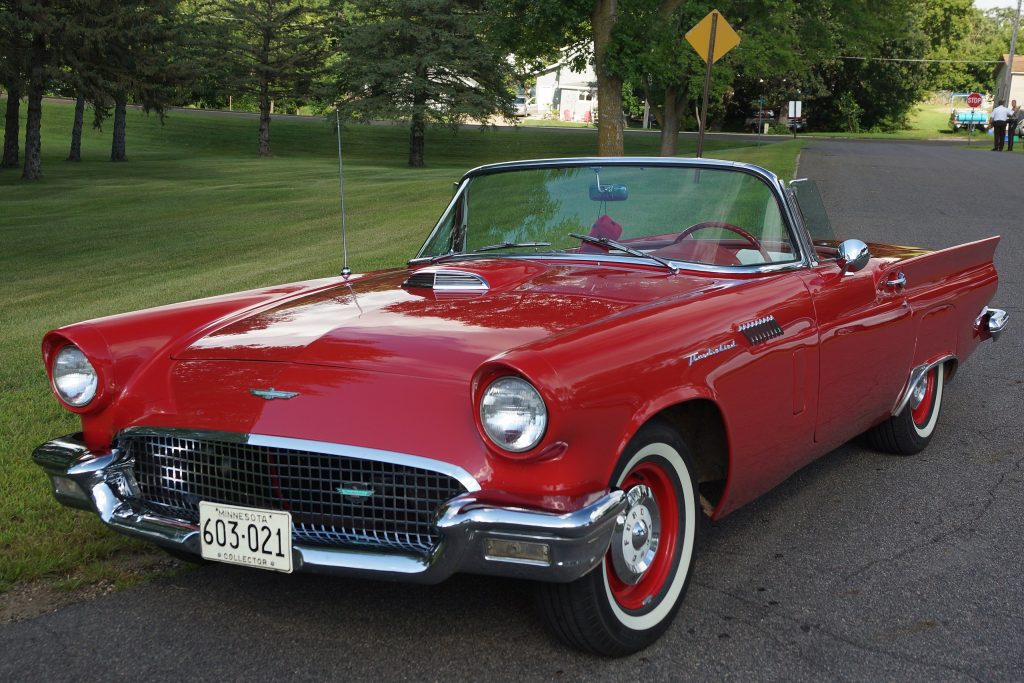
Known as the “Early Birds,” the first generation of the Ford Thunderbird lasted from 1955–1957. Ford built the T-Bird to compete with the Chevrolet Corvette that was introduced a few years earlier by GM. Both were inspired by the European roadsters and sports cars of the 1940s, which caught the attention of countless GIs who were overseas serving in the Second World War. The T-Bird was a two-door, two-seater, that had a removable fiberglass top to make the car into a convertible. Also available was a Rayon top for an extra $300.
Priced at just $2,944 with standard equipment, the T-Bird was just $35 more than a V8 powered Corvette. The T-Bird also made 3 more horsepower than the Corvette, but weighed about 100 lbs more. Still performance was very comparable between the two. The 1955 Ford Thunderbird was incredibly popular, and Ford more than exceeded their 10,000 unit target. More than 16,000 Thunderbirds came off the line in 1955, dwarfing the Corvette production of just 700.
Celebrities loved driving the T-Bird, such as Marilyn Monroe who had a 1956 model. For the 1956 Thunderbird changes were relatively minimal, and mainly included different badging and a new rear bumper that increased storage space. For the 1957 Thunderbird, the tailfins got larger, as did the grille and tail lamps, and the front bumper took a new shape too. Though sales slightly dipped in 1956, they were still strong, and the 1957 Ford Thunderbird broke internal records with more than 21,000 units sold.
1955–1957 Ford T-Bird Engine Technical Specifications
| Model Years | Engine | Horsepower | Torque |
| 1955 | 292 cid V8 (4bbl) | 193 horsepower | 280 lb-ft |
| 1955 | 292 cid V8 (4bbl) | 198 horsepower | 286 lb-ft |
| 1956 | 292 cid V8 (4bbl) | 202 horsepower | 289 lb-ft |
| 1956 | 312 cid V8 (4bbl) | 215 horsepower | 317 lb-ft |
| 1956 | 312 cid V8 (4bbl) | 225 horsepower | 324 lb-ft |
| 1956 | 312 cid V8 (2x4bbl) | 260 horsepower | 330 lb-ft |
| 1957 | 292 cid V8 (2bbl) | 212 horsepower | 297 lb-ft |
| 1957 | 312 cid V8 (4bbl) | 245 horsepower | 332 lb-ft |
| 1957 | 312 cid V8 (2x4bbl) | 270 horsepower | 336 lb-ft |
| 1957 | 312 cid V8 (2x4bbl) | 285 horsepower | 343 lb-ft |
| 1957 | 312 cid V8 (4bbl) (Supercharged) | 300 horsepower | 440 lb-ft |
| 1957 | 312 cid V8 (4bbl) (Supercharged) | 340 horsepower | 450 lb-ft |
First Generation Engines, Transmissions, and Performance
Engine wise, Ford only gave the 1955 one option, a 292 cid V8. There was a high compression (8.5:1) and low compression version (8.1:1), with the high compression version making 5 more horsepower for 198 horsepower total. The following year, Ford introduced a slightly larger 312 cid V8, the Thunderbird Special, which made 215 horsepower, or 225 horsepower with higher compression and the Ford “power pack” option. The most powerful version (260 horsepower) used two-four-barrel carburetors strapped together as a “competition kit.”
In the 1957 Thunderbird, the competition kit 312 V8 upgraded to 270–285 horsepower, but it was soon overtaken as the top dog. Partway through the year, Ford added a supercharged version of the 312 V8, known as option code “F.” The supercharger was a VR-57 McCulloch Paxton single-stage, variable-ratio, centrifugal-style blower. The blower boosted performance to 300 horsepower, or 340 horsepower in the NASCAR version.
Buyers had the option of three transmissions for their T-Bird. Two were manuals and both of those were three-speeds, but one of them did have overdrive. The automatic was another three-speed, the Ford-O-Matic transmission, also known as the Merc-O-Matic or Turbo-Drive.
First Generation Ford Thunderbird Production Numbers
| Model Year | Bodystyle | Production Total |
| 1955 | Thunderbird | 16,155 |
| 1956 | Thunderbird | 15,631 |
| 1957 | Thunderbird | 21,380 |
Second Generation Ford Thunderbird
The second generation of the Ford Thunderbird lasted from 1958–1960, and are known as the “Square Birds.” This generation saw Ford restyle the T-Bird and introduce a new four-seater design for the first time. The new four-seater was pushed by Ford Executive (and later Secretary of Defense) Robert McNamara, and it proved to be extremely popular with buyers.
Motor Trend named the 1958 Ford Thunderbird the Car of the Year, and price had increased sharply from its original 1955 tag. Now, a hardtop Thunderbird cost $3,630 standard equipped, with the convertible option adding $284. A sharp increase from $2,944 in 1955.
Other changes for the 1958 Ford Thunderbird included a longer wheelbase by 11 inches, and a “long and low” roof that almost looked sunken in. The Thunderbird also weighed 1,000 pounds more than before. The Thunderbird still rode very low to the ground compared with other passenger vehicles. For 1958, Ford introduced a convertible top that could be operated and lowered via hydraulic cylinders, which allowed the roof to fit inside the trunk without being exposed, making for an unbroken trunk line. Ford introduced bucket seats as standard for the first time in any American car on the T-Bird in 1958.
Only modest revision occurred for 1959, including a modified hood scoop and new bading/nameplates. In 1960, Ford gave the Thunderbird a new grille and side decorations, but it mostly looked the same, except it also got a third tail light on each side of the bumper. Also available was an optional “Golde Edition” with a sunroof.
In 1959, Ford also used the Thunderbird name on a number of other models, including the Galaxie and Fairlane. These models used the Thunderbird V8 engine, but were otherwise different from actual T-Birds.
1958–1960 Ford T-Bird Engine Technical Specifications
| Model Years | Engine | Horsepower | Torque |
| 1958-1959 | 332 cid V8 (2bbl) | 225 horsepower | 320 lb-ft |
| 1958-1960 | 352 cid V8 (4bbl) | 300 horsepower | 381 lb-ft |
| 1958 | 430 cid V8 (4bbl) (Rumored) | 375 horsepower | 500+ lb-ft |
| 1959-1960 | 430 cid V8 (4bbl) | 350 horsepower | 490 lb-ft |
Second Generation Engines, Transmission Options, and Performance
Ford brought out an entirely new set of engines for the 1958–1960 “Square Birds,” though some sources do indicate the 292 cid V8 was still available making ~200 horsepower. Ford introduced two V8 engines from the FE series, a 332 cid and a 352 cid. The 332 used a double-barrel carb and made 225 horsepower, while the larger 352 used a quad-barrel and made an impressive 300 horsepower. The 352 was also known as the Interceptor-V8 or the Thunderbird-V8. It had a 10.2:1 compression ratio and dual-exhaust system.
While it has never been proven to actually exist, many car magazines from 1958 also advertise that year T-Bird as being available with a 430 cid V8 making 375 horsepower. It’s possible that Ford equipped a few T-Birds with this engine, though no official documentation exists to prove so.
Either way, the following year Ford did introduce a version of the 430 cid V8 into the Thunderbird. This 430 V8 was sourced from Ford’s Marauder V8 line of engines. It made 350 horsepower and 490 lb-ft of torque, and was marketed as the Thunderbird 430 Special-V8 in 1959. Both the 352 and 430 cid V8s lasted until 1960, while Ford dropped the 332 after 1959.
Transmission wise, T-Bird buyers had two options, either a three-speed manual or a three-speed automatic. The automatic was new, the Cruise-O-Matic to replace the Ford-O-Matic. It was essentially the same transmission, but stronger and with some updates.
In 1959 and 1960, the Ford Thunderbird saw use as a stock car for NASCAR. It broke dozens of records during its brief run, and was one of the best looking cars on the track.
Second Generation Ford Thunderbird Production Numbers
| Model Year | Bodystyle | Production Total |
| 1958 | Hardtop | 35,758 |
| Convertible | 2,134 | |
| 1958 Total | 37,892 | |
| 1959 | Hardtop | 57,195 |
| Convertible | 10,261 | |
| 1959 Total | 67,456 | |
| 1960 | Hardtop | 80,938 |
| Convertible | 11,860 | |
| 1960 Total | 92,798 |
Third Generation Ford Thunderbird
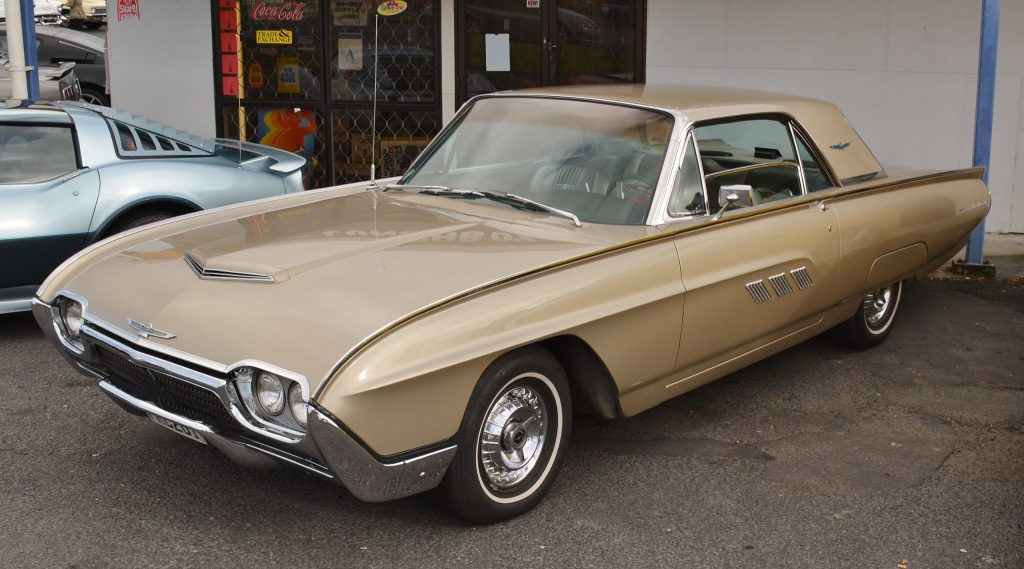
Ford built the third generation of the Thunderbird from 1961–1963, and they are widely known as the “Bullet Birds.” Like a bad habit, the designers at Ford completely dropped the Square Bird design, making the third generation Thunderbird curved and sleek, almost like a bullet. No doubt inspired by the burgeoning space race, with new era jets and rockets looking like the future, the “Bullet Bird” was also known as the “Rocket Bird” or “Projectile Bird” by many.
For the 1961 Thunderbird, Ford used the brand new “Swing Away” steering column, which could be pushed to the left when the car was in park to allow the driver to enter and exit the car much easier. Buyers could also now operate the convertible through the use of a switch on their door. Ford priced the 1961 Thunderbird at $4,170 for the hardtop and $4,637 for the convertible, another swift increase from the start of the prior generation in 1958.
For the 1962 Ford Thunderbird there were even more changes in store. In addition to new headlights and a new grille, Ford introduced the Landau and Sports Roadster models. The Sports Roadster placed a cover over the rear seats, making it all about performance. The convertible had to be down for the tonneau cover, but it was very stylish – though it sold poorly.
The Landau hardtop had a black and white vinyl top designed to look like a carriage, and had an all-leather interior. Buyers had 18 different options for paint color, including 12 Thunderbird-specific options. Little changed in 1963 except the grille and the price, which got more expensive.
1961–1963 T-Bird Engine Technical Specifications
| Model Years | Engine | Horsepower | Torque |
| 1961-1963 | 390 cid V8 (4bbl) | 300 horsepower | 427 lb-ft |
| 1961 | 390 cid V8 (4bbl) (Special) | 375 horsepower | 427 lb-ft |
| 1961 | 390 cid V8 (3x2bbl) (Special) | 401 horsepower | 430 lb-ft |
| 1962-1963 | 390 cid V8 (3x2bbl) (M-Code) | 340 horsepower | 430 lb-ft |
| 1962-1863 | 406 cid V8 (4bbl) (Special) | 385 horsepower | 444 lb-ft |
| 1962-1963 | 406 cid V8 (3x2bbl) (Special) | 405 horsepower | 448 lb-ft |
| 1963 | 427 cid V8 (4bbl) (Rumored) | 410 horsepower | 476 lb-ft |
| 1963 | 427 cid V8 (2x4bbl) (Rumored) | 425 horsepower | 480 lb-ft |
Third Generation Engines, Transmission Options, and Performance
For the 1961 “Bullet Birds,” Ford ditched the old V8s and introduced a new 390 cid V8. The standard T-Bird 390 V8 made 300 horsepower, but there were more options from Ford. Branded as the Thunderbird Special and Thunderbird Special 6V (for 6 venturi), Ford introduced a 385 horsepower and 401 horsepower version of the 390 for 1961. The 385 horsepower version used a Holley four-barrel, while the 401 horsepower version used a tri-power setup with three Holley double-barrels put together for a 6 venturi carb.
In 1962, Ford introduced the M-code version of the 390 V8, which made 340 horsepower. It had a 10.5:1 compression ratio vs the 9.6:1 on the standard 390. For the Thunderbird Specials, Ford upgraded the 390 to the now legendary 406 cid V8. With a four-barrel carb, the Thunderbird 406 pushed out 385 horsepower, and with the tri-power setup it made 405 horsepower. Compression was very high, at 11.4:1 (385 horsepower) and 11.3:1 (405 horsepower).
While listed as Thunderbird Specials by Ford’s marketing team, it’s unclear if either the higher performance 375/401 horsepower 390 V8 or the 385/405 horsepower 406 V8 were ever actually installed in any production Thunderbirds. Documentation does not exist, though many have claimed over the years that it was available as an option.
The same is true of Ford’s 427 cid V8 they introduced in 1963. Available with a four-barrel carb (410 horsepower) or a tri-power carb (425 horsepower), rumors are that at least a few dealerships offered the 427 as a Thunderbird option in 1963, though the veracity of those claims are unverified. If so, these would be the most powerful Thunderbirds ever built.
Transmission-wise, only the three-speed Cruise-O-Matic was available and all manuals were dropped.
Third Generation Ford T-Bird Production Numbers
| Model Year | Bodystyle | Production Total |
| 1961 | Hardtop | 62,535 |
| Convertible | 10,516 | |
| 1961 Total | 73,051 | |
| 1962 | Hardtop | 69,554 |
| Convertible | 7,030 | |
| Roadster | 1,427 | |
| 1962 Total | 78,011 | |
| 1963 | Hardtop | 56,954 |
| Convertible | 5,913 | |
| Roadster | 455 | |
| 1963 Total | 63,322 |
Fourth Generation Ford Thunderbird
The fourth generation Ford Thunderbird lasted from 1964–1966, and are alternatively known as the “Flair Birds.” Once again, Ford completely restyled the Thunderbird for a new generation. Price increases were more modest to start the fourth generation off. The base went for $4,486, with the Landau a $103 increase and the convertible an increase of $367.
The hood was lengthened to fit in with the bumpers and the roof line was shortened, and it weighed 300 pounds more. The “Flair Birds” reverted to a more square styling than the “Bullet Birds” had, and introduced the “eyebrow” headlights. The 1964 Thunderbird also had the model spelled out on the grille, the only year to do so.
Ford initially kept the Sports Roadster model for 1964, but dropped it after only selling 50 units over the year. They continued the Landau model with its vinyl top and added more color options. By 1965, buyers could get the T-Bird in as many as 20 different colors, with 11 of them unique to the Thunderbird only. That year the standard brakes were upgraded to Kelsey-Hayes vented disc brakes, which were huge improvements for the heavy car.
In the 1966 Thunderbird, Ford gave it a more aggressive front end, with a redesigned hood and grille. That year, Ford also introduced the Town Sedan models as a more formal and luxury version. It included blinded quarter panels, and could be had with an optional Landau package. The fourth-generation T-Birds proved to be very popular with celebrities and Hollywood, as everyone from Sean Connery (as James Bond) to Dean Martin drove them.
1964–1966 T-Bird Engine Technical Specifications
| Model Years | Engine | Horsepower | Torque |
| 1964-1965 | 390 cid V8 (4bbl) | 300 horsepower | 427 lb-ft |
| 1964-1965 | 427 cid V8 (4bbl) (Rumored) | 410 horsepower | 476 lb-ft |
| 1964-1965 | 427 cid V8 (2x4bbl) (Rumored) | 425 horsepower | 480 lb-ft |
| 1966 | 390 cid V8 (2bbl) | 275 horsepower | 401 lb-ft |
| 1966 | 390 cid V8 (4bbl) | 315 horsepower | 427 lb-ft |
| 1966 | 428 cid V8 (4bbl) | 345 horsepower | 462 lb-ft |
Fourth Generation Engines, Transmission Options, and Performance
Engine-wise, the fourth generation Thunderbird was pretty much the same as the third generation, at least at first. Ford kept the 390 cid V8 making 300 horsepower, but they dropped the 340 horsepower M-code version. Introduced in 1963, the 427 cid V8 making 410/425 horsepower was also rumored to be available as an over-the-counter option from a few dealerships through 1965. However, no official documentation exists to support this.
Engines remained the same in 1965, but changed slightly for the 1966 Ford Thunderbird. That year, the 390 V8 was available in two flavors, a 275 horsepower double-barrel version or a 315 horsepower quad-barrel version. Ford also brought out the 428 cid V8 inside the Thunderbird for 1966. It used a quad-barrel C6SF carburetor (the same as on the 315 horsepower 390 V8), and made 345 horsepower.
For the fourth generation, only automatic transmissions were available. The three-speed Cruise-O-Matic was continued from the prior generation, and a new SelectShift C6 transmission was introduced. This was a heavy-duty transmission only meant for more powerful engines that used lots of torque, like the 400+ cid V8s.
Fourth Generation Ford T-Bird Production Numbers
| Model Year | Bodystyle | Production Total |
| 1964 | Hardtop | 60,552 |
| Landau | 22,715 | |
| Convertible | 9,198 | |
| 1964 Total | 92,465 | |
| 1965 | Hardtop | 42,652 |
| Landau | 25,474 | |
| Convertible | 6,846 | |
| 1965 Total | 74,972 | |
| 1966 | Hardtop | 13,389 |
| Convertible | 5,049 | |
| Town Hardtop | 15,633 | |
| Town Convertible | 35,105 | |
| 1966 Total | 69,176 |
Fifth Generation Ford Thunderbird
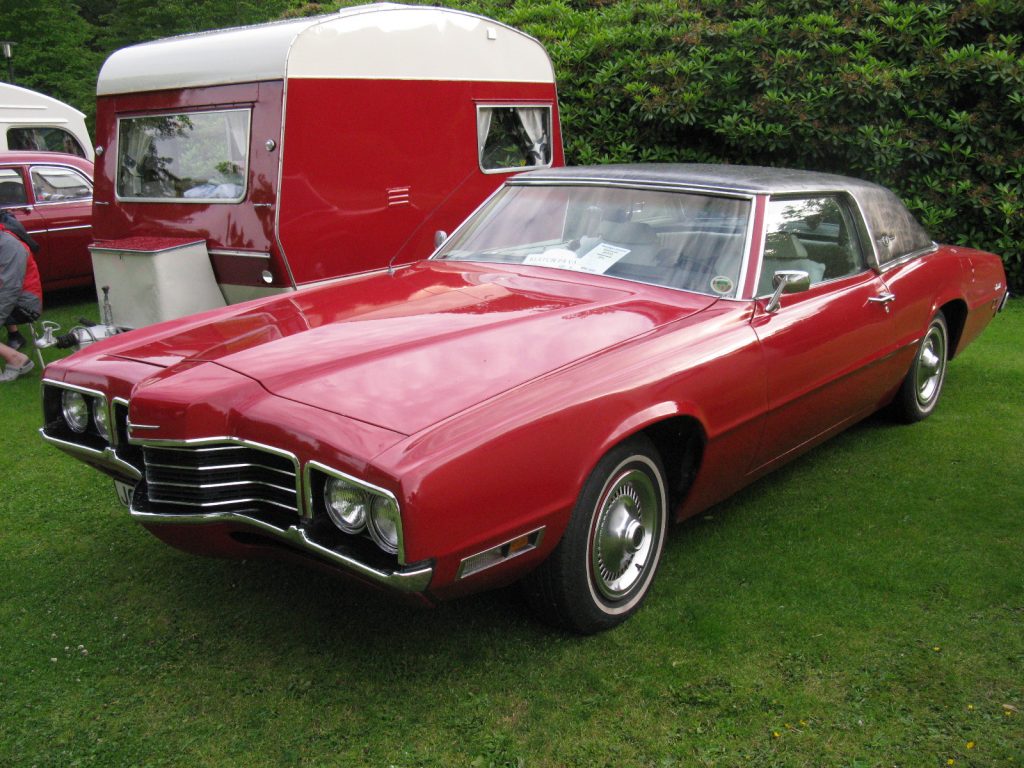
Ford’s fifth generation of the Thunderbird lasted from 1967–1971, and were known as the “Glamour Birds” (‘67–’69) and as “Bunkie’s Birds” (1970–1971). The latter got their name from Semon “Bunkie” Knudsen, the President of Ford who was the impetus behind the changes from the 1969–1970 model years.
Compared with the fourth generation, the 1970 Ford Thunderbird looked much different. Gone was the traditional unibody chassis, which Ford replaced with a semi-unit body, and they introduced a new all-coil spring suspension. With the introduction of the Pontiac GTO and Ford’s Mustang in the years prior, Ford engineers gave the Thunderbird a more muscle-esque long hood, short deck styling and “coke bottle” design.
The Thunderbird was also quieter now than before, with noticeable improvements to NVH being prioritized. Many saw the Thunderbird as Ford competing with the new Jaguar Mark II and Maserati Quartrroporte. But the big news was the replacement of the convertible with a four-door Landau model for the 1967 Ford Thunderbird. The four-door Landau had rear doors that opened out from the center, “suicide” style, giving them a unique flair.
In 1968, Ford rearranged the interior on the hardtop coupes to fit six instead of four passengers. In 1970, the new President of Ford, Knudsen, heavily influenced the new T-Birds. The new 1970 Thunderbird rode lower and was longer, the hood was angled more, and the grille protruded out to look almost like a bird beak. For the most part, the 1971 Thunderbird looked the same, but with slight changes to the grille.
1967–1971 T-Bird Engine Technical Specifications
| Model Years | Engine | Horsepower | Torque |
| 1967 | 390 cid V8 (2bbl) | 275 horsepower | 401 lb-ft |
| 1967-1968 | 390 cid V8 (4bbl) | 315 horsepower | 427 lb-ft |
| 1967 | 428 cid V8 (4bbl) | 345 horsepower | 462 lb-ft |
| 1968-1969 | 390 cid V8 (2bbl) | 265 horsepower | 401 lb-ft |
| 1968 | 390 cid V8 (2bbl) | 280 horsepower | 427 lb-ft |
| 1968 | 428 cid V8 (4bbl) | 340 horsepower | 462 lb-ft |
| 1968-1971 | 429 cid V8 (4bbl) (ThunderJet) | 360 horsepower | 480 lb-ft |
| 1969 | 390 cid V8 (4bbl) | 320 horsepower | 427 lb-ft |
| 1969-1970 | 429 cid V8 (2bbl) (ThunderJet) | 320 horsepower | 460 lb-ft |
| 1970 | 390 cid V8 (2bbl) | 270 horsepower | 390 lb-ft |
Fifth Generation Engines, Transmission Options, and Performance
From 1967 Ford kept the same engines available at the same power outputs, but that changed for the 1968 Ford Thunderbird. They kept the 315 horsepower 390 V8, but the two-barrel version dropped to 265/280 horsepower (low/high compression models). The larger 428 cid V8 also dropped to 340 horsepower, a 5 horsepower decrease from the year prior.
In 1968, Ford also introduced the ultra-high performance ThunderJet V8. This was a 429 cid V8 using a four-barrel carb with 10.0:1 compression, making 360 horsepower and 480 lb-ft of torque. It required premium fuel, but was only available with the SelectShift automatic transmission and not the Cruise-O-Matic. With the ThunderJet V8, the Thunderbird could go from zero to 60 mph in 9.5 seconds, which was not bad considering the car’s extravagant weight.
Ford continued the 360 horsepower ThunderJet through 1971, and they also introduced a less powerful 320 horsepower version that used a double instead of quad-barrel carb. For 1971, Ford dropped all choices except the four-barrel, 360 horsepower ThunderJet, which remained unchanged.
Transmissions available were the Cruise-O-Matic or the SelectShift C6. Ford dropped the Cruise-O-Matic in 1971, as the ThunderJet was only available with the heavy-duty SelectShift C6.
Fifth Generation Ford T-Bird Production Numbers
| Model Year | Bodystyle | Production Total |
| 1967 | Hardtop | 15,567 |
| Two-Door Landau | 24,967 | |
| Four-Door Landau | 37,422 | |
| 1967 Total | 77,956 | |
| 1968 | Hardtop | 9,977 |
| Two-Door Landau | 33,029 | |
| Four-Door Landau | 21,925 | |
| 1968 Total | 64,931 | |
| 1969 | Hardtop | 5,913 |
| Two-Door Landau | 27,664 | |
| Four-Door Landau | 15,650 | |
| 1969 Total | 49,227 | |
| 1970 | Hardtop | 5,116 |
| Two-Door Landau | 36,847 | |
| Four-Door Landau | 8,401 | |
| 1970 Total | 50,364 | |
| 1971 | Hardtop | 9,146 |
| Two-Door Landau | 20,356 | |
| Four-Door Landau | 6,553 | |
| 1971 Total | 36,055 |
Sixth Generation Ford Thunderbird
The sixth generation of the Ford Thunderbird lasted from 1972–1976, and are known as the Big Birds. These Thunderbirds were the biggest yet, thanks to the input of Lee Iacocca, and were based on the Lincoln Continental Mark IV. Gone was the larger four-door Landau model from before, with only the two-door hardtop remaining. It was the heaviest T-Bird yet, weighing 4,500 pounds with zero options.
In 1973, Ford had to implement bumpers that could withstand crashes of 5 mph as part of new federal regulations. They had dropped the sequential turn signals the year prior, but also added new opera windows for the rear. Anti-lock brakes were a new option, too. Interior-wise, the Thunderbird used most of the same styles as the Mark IV Continental.
1972–1976 T-Bird Engine Technical Specifications
| Model Years | Engine | Horsepower | Torque |
| 1972 | 429 cid V8 (4bbl) | 212 horsepower | 327 lb-ft |
| 1972 | 460 cid V8 (4bbl) | 224 horsepower | 342 lb-ft |
| 1973 | 429 cid V8 (4bbl) | 208 horsepower | 327 lb-ft |
| 1973 | 460 cid V8 (4bbl) | 219 horsepower | 338 lb-ft |
| 1974 | 460 cid V8 (4bbl) | 220 horsepower | 335 lb-ft |
| 1975 | 460 cid V8 (4bbl) | 194 horsepower | 355 lb-ft |
| 1976 | 460 cid V8 (4bbl) | 202 horsepower | 355 lb-ft |
Sixth Generation Engines, Transmission Options, and Performance
For the sixth generation engines, Ford kept the 429 V8 for 1972, but it was severely down on power. Much of this had to do with emissions regulations, which gutted most muscle and luxury cars of their performance. The 429 made just 212 horsepower now, down considerably from the 360 the year prior. However, part of this also had to do with Ford rating their engines by SAE Net instead of SAE Gross – another federal regulation – which made the cars appear less powerful even less powerful than they were.
Partly to help make up some of the power, Ford introduced a gigantic 460 cid V8. It came from the same Ford Lima engine family as the 429, and made 224 horsepower. The year prior, the 460 had been rated at 365 horsepower (gross), but it changed to SAE Net ratings and had a lower compression ratio, making it less powerful inside the Thunderbird.
Ford would offer the 429 only until 1973, when they dropped it in favor of having the 460 as the sole engine option. By 1976, the 460 made just 202 horsepower, though the 355 lb-ft of torque did help it off the line. Still, with the massive 5,000 pound curb weight, the Thunderbird was a much less exhilarating car to drive from 1972-on.
Sixth Generation Ford T-Bird Production Numbers
| Model Year | Production Plant | Production Total |
| 1972 | California Built | 22,229 |
| Michigan Built | 35,585 | |
| 1972 Total | 57,814 | |
| 1973 | California Built | 40,593 |
| Michigan Built | 46,676 | |
| 1973 Total | 87,269 | |
| 1974 | California Built | 20,500 |
| Michigan Built | 37,943 | |
| 1974 Total | 58,443 | |
| 1975 | California Built | 18,230 |
| Michigan Built | 24,455 | |
| 1975 Total | 42,685 | |
| 1976 | Thunderbird | 52,935 |
Ford Thunderbird Legacy
The first six generations of the Ford Thunderbird were incredibly successful and established the car as one of the best on the American market. It changed throughout the years, but largely stayed as a personal luxury car that offered the best performance Ford had available for the street. Its iconic tailfin styling and raised headlights made it stand out from the rest, and it still stayed unique even after those features left.
The Thunderbird started as a two-door, two-seater, before Ford later introduced four-seater, six-seater, and four-door options. However, by 1976 the Thunderbird was back where it started, as a two-door hardtop coupe – though now with room for four. Engines grew in size from 292 cid all the way up to 460 cid, and one of them was even supercharged.
Nowadays, early 1-5 generation Thunderbirds are hot commodities for vintage collectors, with the ThunderJets being some of the most sought out of all time. Make sure to check out our other article on the 7-11 generation Thunderbirds.
*Thanks to John Gunnell and James T. Lenzke’s “T-Bird: 45 Years of Thunder,” for production numbers, engine figures, and other information.
**Thanks to John Gunnell’s “Standard Catalog of Ford, 1903–2003,” for production numbers, engine figures, and other information.

